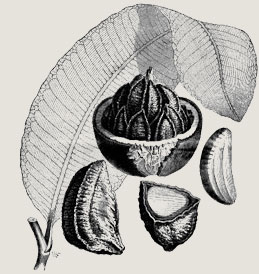Brazil nuts
 The Brazil nut can be mainly found in Brazil, Paraguay, Bolivia, Peru and Venezuela. The Brazil nut became known in Europe because a Spanish officer fed his starving men with Brazil nuts. These men soon recovered as a result of the energy and nutritional value of the Brazil nut.
The Brazil nut can be mainly found in Brazil, Paraguay, Bolivia, Peru and Venezuela. The Brazil nut became known in Europe because a Spanish officer fed his starving men with Brazil nuts. These men soon recovered as a result of the energy and nutritional value of the Brazil nut.
Eye-catching tree
The Brazil nut resembles a coconut and grows on a tree that is 40 to 60 metres high with a diameter of about two metres. In the wild, this eye-catching tree can be found in the Brazilian Amazon area. The tree is gigantic and towers above everything and everyone. The Brazil nut is aptly named after its most important country of origin. Fruit (hard balls) falls from the tree during the months of November to March. These balls contain eight to twelve seeds, known as Brazil nuts, in the shell.
Nutritional value
 Brazil nuts are very rich in the mineral selenium, owing to the soil in the sun-drenched Amazon area where they grow. A handful of Brazil nuts contain at least 480% of the GDA of selenium. Selenium is an important antioxidant, as is vitamin E in nuts. Brazil nuts also contain a high level of phosphorus. Phosphorus keeps teeth and bones strong.
Brazil nuts are very rich in the mineral selenium, owing to the soil in the sun-drenched Amazon area where they grow. A handful of Brazil nuts contain at least 480% of the GDA of selenium. Selenium is an important antioxidant, as is vitamin E in nuts. Brazil nuts also contain a high level of phosphorus. Phosphorus keeps teeth and bones strong.
Further informationen to other nuts:
Nutritional value Brazil nuts
| Brazil nuts | Nutritional value per 100 grams | RDA |
|---|---|---|
| Energy | 2870 kJ / 696 kcal | |
| Protein | 14.0 g | |
| Carbohydrates | 6.0 g | |
| o.w. sugars | 2.0 g | |
| Fats | 67.0 g | |
| o.w. saturated | 19.0 g | |
| o.w. mono unsat. | 22.0 g | |
| o.w. poly unsat. | 25.0 g | |
| Dietary fiber | 6.0 g | |
| Sodium | 2.0 mg | |
| Calcium | 175.0 mg | 22.0% |
| Magnesium | 350.0 mg | 93.0% |
| Phosphorus | 700.0 mg | 100.0% |
| Iron | 2.8 mg | 20.0% |
| Zinc | 4.5 mg | 45.0% |
| Vitamin B1 | 0.6 mg | 55.0% |
| Vitamin B2 | 0.0 mg | 0.0% |
| Vitamin B3 | 0.3 mg | 2.0% |
| Vitamin E | 6.0 mg | 50.0% |
| Folic acid | 22.0 mcg | 11.0% |
RDA = Recommended Daily Amount
Warning: Small children can choke on nuts.

